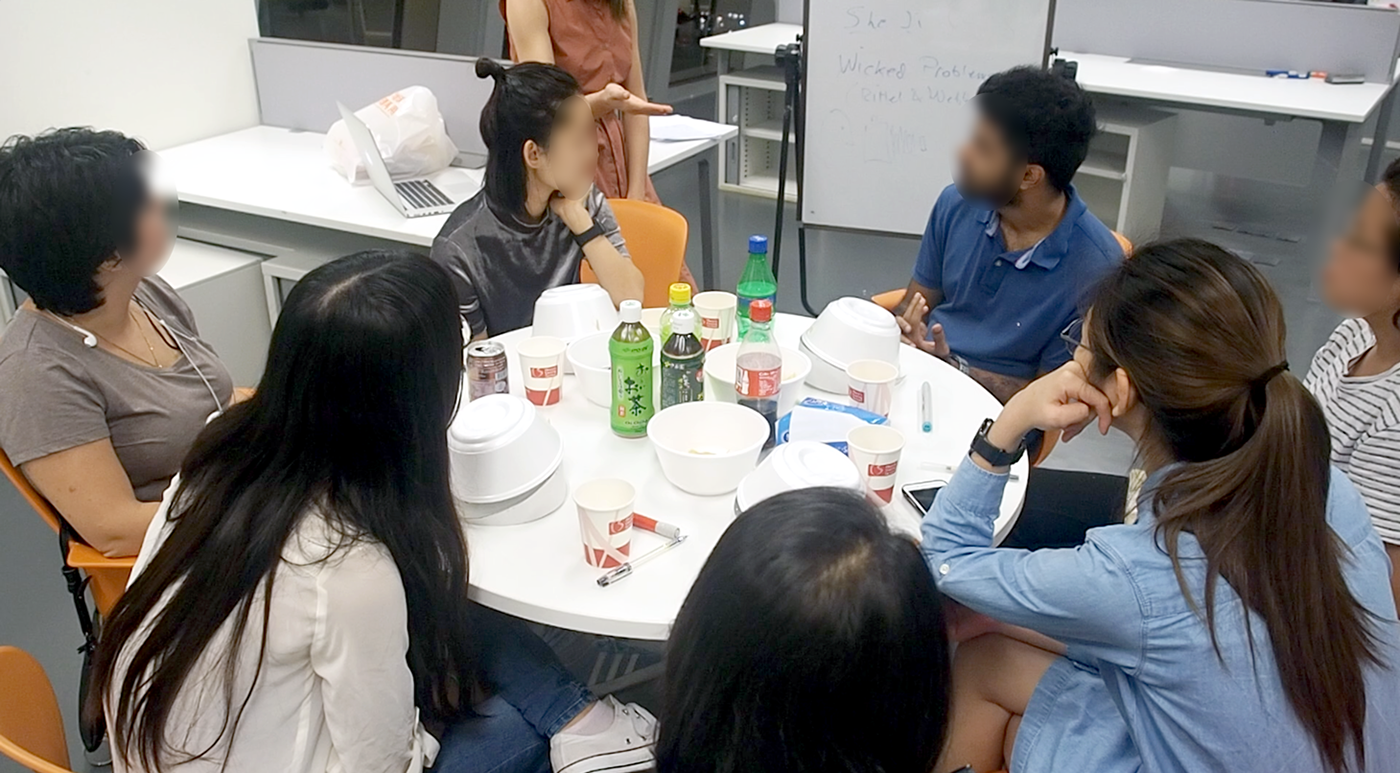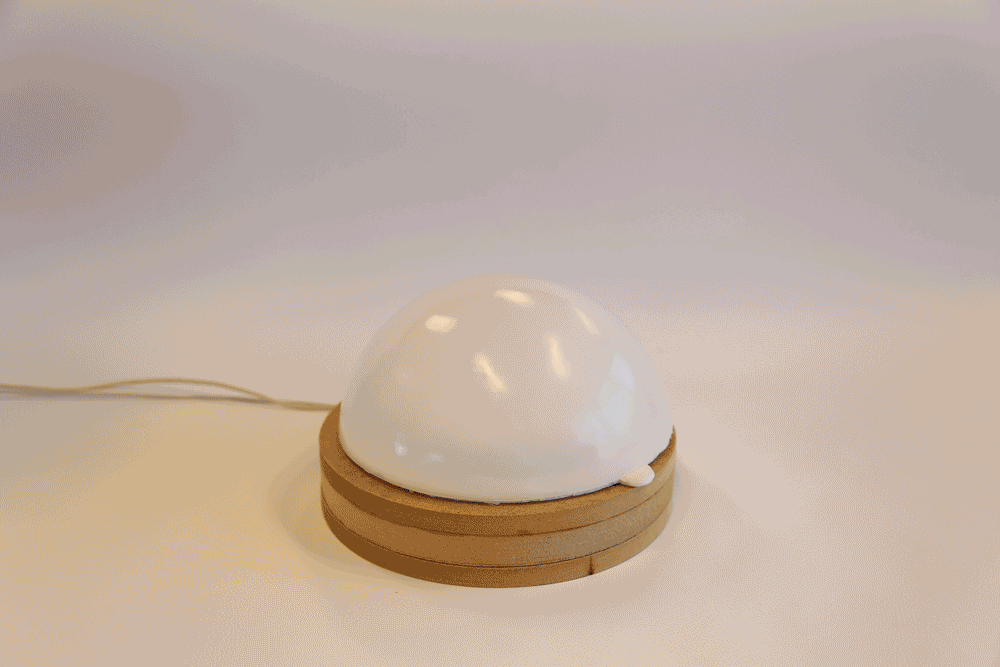Aiuto Lamp
You, your phone and taking back your time
Aiuto (Latin “help”) lamp is a design response to an open brief—conscious consumption of mobile phones. It’s a lifestyle lamp that allows user to hide their phone inside the lamp and therefore take a break from a screen and aggressive information delivery. Lamp charges phone, blocks notifications, and works as a speaker either playing music, narrating an audiobook or a meditation. Primary function of the lamp is to provide user with phone-free time in 2 critical time slots of the day—at night before going to bed and in the morning right after waking up. In the evening lamp dims down over time suggesting user it’s a time to sleep, while in the morning it takes on the role of an alarm preventing user from checking their phone first thing in the morning.
Final delivery for the project—limited functionality medium fidelity prototype.
Project type
Team
Collaborators
Yangqu Yuki Chen
Advisors
My roles
Actively participated at every research activity; Shared a leadership position together with another team-member; Culture probes creation; Interviewer; Literature and market review; Scenario writing & acting; Sketching; Prototyping; Participatory design workshop facilitator.
Research methods & tools
Culture probes, Literature review, Scenarios (text & video), User journey, Brainstorming, Sketch, Lo-fi prototyping, Participatory design, Med-fi prototyping.
Timeline
Sept 15 - Dec 15, 2016
Research - 6 weeks
Prototyping & Evaluation - 5 weeks
Research








In order to better understand relationship between people and their phones we deployed culture probes. Most successful probes were those, where we provoked people to look at their phones from a new perspective—write an obituary for a phone, “phone as a body”; and those where we explored relationship between phone and life—for example, mark favorite restaurant on the map and write why it’s their favorite. Former allowed people to look at an ordinary item from a creative point of view, latter—to tell their own stories.
Insight
Many participants treat their phones as close friends or helpers.
Insight
Apps like yelp and openrice are certainly effective, but they play a limited role in memory creation.
Through literature review we identified that there are crucial screen-free times around the bedtime—in the morning and at night. Many people are trying to stay away from their phone at those times, but have hard times.

Source: mymorningroutine.com/statistics
Insight
Some people try to limit their phone usage around bedtime—in the morning and at night.
Design problem
While technology is a great assistant in our daily life, it is also a great distraction from our goals and aspirations.
__________
In order to better understand our use case scenario and potential user, we turn our attention to informance research method, producing text and video scenarios. It helped us to map existing user journey and identify pain points.
Average morning routine
Text scenario
It’s Sunday. Carol has a new day in front of her, it’s an early morning and she woke up ahead of time to do some yoga before catching up with her friends for a breakfast at 11am.
She reaches to her phone to switch off morning alarm, when she notices a notification from the last night—a friend invited her to have a dinner together. Carol have never been to proposed restaurant, so she checks reviews & pictures on OpenRice, after that she opens Google maps app to check where it is located and how long it will take her to get there. Google maps has a link to Yelp, so she is checking what Yelp community thinks of the restaurant.
The same moment a notification about a new comment on Instagram pops up. Carol instantly opens an Instagram app to check and reply, but the feed is so interesting, she can’t help but checking few pictures here and there, check some commenter’s profile and go through their pictures.
A moment after her alarm is on again this time reminding her to get out of apartment in the next 15 mins, otherwise she’ll be late for a breakfast with her friends.
No time for yoga left. Carol rushes to get up and get out of her flat.
Potential User
Based on Fogg’s Behavior Model we decided to focus on people, who already have high motivation and understanding how their cell phone negatively intrudes into their life, and support them with high ability (through low physical effort) to reject their phone, when they are willing to do so.
- Person who is aware of how much they use their phone daily;
- Person who knows how device distracts them from certain activities, therefore they are willing to experiment;
- Person who is health-conscious, takes an active role in her / his mental wellbeing.
And this lead us to preliminary product design characteristics:
- Enable people to achieve their personal goals without distractions from their devices;
- Initiative to use the product should come from the user, not product;
- Work for specified (by user) amount of time;
- Substitute some basic functions that phones perform (clock, music, alarm, timer);
- Give positive impression, considered as helper;
- Feel more physical, than technological;
- Give feelings of Zen, nature, calm;
- Easy to set up and operate.

Sketching
Brainstorming & Ideation
During ideation we arrived at the concept of trade or exchange, where user is trading their phone in exchange for some “good to have” functions.
Since we were looking at a bedtime the choice of product for us was a bedside table lamp, with a trading function—phone for light.







Participatory Design
In order to identify functionality of the lamp and prove the concept we invited users to participate in the design process. Workshop was arranged in a way that we provided users with lo-fi prototypes saying that the only function of this device is to hide phone, and invited them to brainstorm potential use case scenarios, good to have functions.

Participatory workshop
Insight
Many participants experienced frustrations of being distracted by their phone from intended activity.
During the workshop our participants arrived at the concept of a bedside lamp with:
- charger,
- speaker,
- possibility to lock a phone for specified amount of time,
- clock/alarm,
- radiation protection,
- emergency call/notifications,
- audiobook narration,
- notification that phone is inaccessible,
- gamification of experience.
Improvements for a physical product:
- reveal instead of rotate for opening,
- adjust the angle at which phone is positioned.

Limited functionality medium fidelity prototype
Design evaluation
For design evaluation we produced a medium-fidelity prototype with limited functionality.
There are simple 2 buttons within the lamp—in a phone-charging area, and at the surface of the bottom part of the lamp. When both of them are pressed, assuming that the phone is inside and the top part of the lamp is closed, light turns on. Light stays on for 5 minutes and dims down to a full off within the last minute. There is a simple phone charger inside of the lamp.
The main aim of a user testing session was to prove that:
- Lamp brings a positive experience;
- Removing a phone from the eyesight helps to forget about it.
Evaluation activity was arranged around 5-minute mediation activity. First we quickly interview them about their stress level. Then we asked a user to place their phone inside of the lamp and close their eyes. After we played a 5-minute meditation from Youtube, and later interviewed about the experience.
Due to project limitations and the level of prototype development (medium-fidelity), we were not able to set up evaluation session in a natural environment, though it would be very beneficial to deploy a hi-fi prototype to participant’s homes for several days and ask them to use it as a bedside table lamp.









- Participants find the experience with the lamp relaxing, calming, peaceful. It helped them to release the stress from the everyday life and recharge quickly.
- Many would like to use the product before falling asleep as a bedside table lamp.
- The shape of the product feels natural, evokes positive emotions.
- Several participants tapped, touched the lamp, referred to it as a friend or a pet.
- Several participants forgot that their phone was inside of the lamp, many agree that removing the phone from the eyesight helps to not pay attention to it.
Future development direction
Scenario improvements:
- Assist user to build a habit of using lamp (potentially through visual cues) in the first few weeks of usage;
- Morning routine of lamp - to prevent a user walk out of apartment with their phone forgotten in the lamp;
Features:
- Possibility to customize initial brightness of light.
- Emergency contact list and receiving notifications from the contacts on the list, while the phone is inside the lamp.
- Different modes / scenarios with different duration - 1 hour before bed, quick 5 minutes meditation break, audiobook, or just a music speaker without duration.
Physical product improvements:
- Better/higher quality materials, pleasant to touch.
Thank you for reading!


